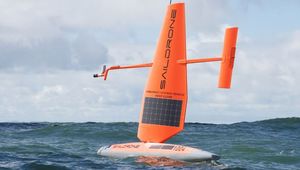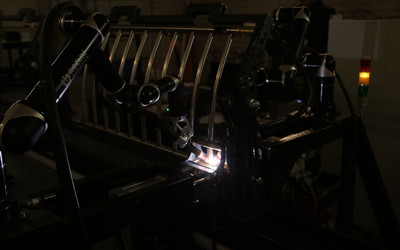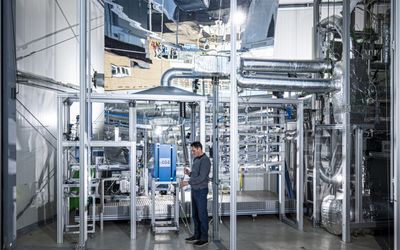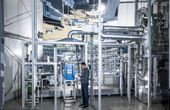PackBot
An agile, mobile robot used for bomb disposal, search, and hazardous environments. It can climb stairs, drive through mud, and operate in all-weather conditions. The man-portable, easy-to-use 510 PackBot features a modular design, incorporating an array of sensors and interchangeable payloads. It can be deployed in less than two minutes. The 510 PackBot accommodates eight payload bays. The front bay is mounted with an enhanced awareness payload (EAP) equipped with a wide-angle drive camera. The robot is also attached with a Manipulator 1.0 (510 3-Link Arm) to inspect hazardous materials. A 312x zoom adjustable turret camera with white and infrared lights is mounted at the end of Manipulator 1.0 to provide a wide range of views for safe inspection of objects
Technical Specifications
| Weight | 23.9 |
| Height | 17.8 |
| Width | 52.1 |
| Speed | 9.3 |
| Length | 88.9 |
Overview
The 510 PackBot is a multi-mission tactical mobile robot developed and manufactured by iRobot. It is designed for use by warfighters and first responders to carry out dangerous missions in high-threat battlefield scenarios.
The 510 PackBot can perform surveillance and reconnaissance, chemical, biological, radiological and nuclear (CBRN) detection, building and route clearance, explosive ordnance disposal (EOD), HazMat handling, improvised explosives device (IED) detection, checkpoint, and vehicle and personnel inspections. It can be easily configured based on the operators’ mission needs.
More than 2,000 510 PackBot robots are deployed in Iraq and Afghanistan, and over 5,000 PackBots have been delivered to military and civil defence forces across the world.
Design and features
The man-portable, easy-to-use 510 PackBot features a modular design, incorporating an array of sensors and interchangeable payloads. It can be deployed in less than two minutes and operates under all weather conditions.
The 510 PackBot has a length of 68.6cm with flippers stowed and about 88.9cm with flippers extended. The height with no payload / manipulator is 17.8cm and the width with flippers is 52.1cm. It weighs approximately 10.89kg without batteries. It is equipped with mechanical cable cutters, a PAN disruptor mount and a head-mounted hook. A route clearance kit is attached to remove and probe buried obstacles.
Payloads, sensors and communications
The 510 PackBot accommodates eight payload bays. The front bay is mounted with an enhanced awareness payload (EAP) equipped with a wide-angle drive camera. The robot is also attached with a Manipulator 1.0 (510 3-Link Arm) to inspect hazardous materials. A 312x zoom adjustable turret camera with white and infrared lights is mounted at the end of Manipulator 1.0 to provide a wide range of views for safe inspection of objects.
The machine is also fitted with a small arm manipulator (SAM) featuring a fixed-focus colour camera to perform manipulation, interrogation and inspection. The User-Assist Package (UAP) of the robot facilitates semi-autonomous functionality and enhanced situational awareness.
The robot incorporates a variety of communications systems such as a digital mesh radio kit with a frequency of 2.4GHz / 4.9GHz, two-way audio module, a headphone with microphone and a global positioning system. Multiple high-resolution cameras are also installed to capture real-time imagery and video.
The 510 PackBot’s digital architecture also includes a LWIR thermal camera, a Flir Fido explosives detection sensor for ultra-sensitive vapour detection and a HazMat kit to detect chemical and biological materials.
Operation and control of PackBot
The robot is remotely operated by two game-style hand controllers. It employs iRobot Aware 2 fifth-generation robot intelligence software.
A lightweight 15in Amrel laptop operator control unit (OCU) is used to store the high-resolution real-time imagery and video for post mission analysis. The unit can also store manipulator arm poses and display robot location, orientation and its battery life. It also displays keyboard shortcuts to operate and control the robot without using a hand controller.
Power and performance of the robot
The 510 PackBot robot is powered by two BB-2590/U Li-ion rechargeable batteries, which provide continuous power for more than four hours. The robot is also provided with a set of BB-2590/U Li-ion spare batteries, two BB-2590 battery cradles and a battery charger.
The PackBot can climb stairs and navigate through narrow surfaces; it can traverse rubble, rock, mud, snow and other difficult terrains.
The multi-mission robot has a speed of approximately 9.3kmph, can negotiate grades of approximately 60° and can operate in water depths of up to 3ft.
Sensors
The PackBot includes digital video, FLIR, and GPS capabilities, along with an onboard mobile processor, a wireless teleoperation interface, and full Operator Control Unit (OCU) hardware and software. For the Wayfarer UGV,
we added sensors and perception software for autonomous navigation. These sensors include a Point Grey
Bumblebee/Triclops stereo vision system that will provide 3D range data, a SICK LMS laser rangefinder that will
provide high-resolution, high-accuracy planar range data, and a Crossbow Inertial Measurement Unit that will provide
precise position and orientation information. The data from both range sensors will be fused to detect obstacles, build a map of the surrounding environment, and determine street bearings for road following.
References
Bachelor Thesis written at Worcester Polytechnic Institute. Discusses the object recognition software development of the robot, lists the steps taken to mount the required sensors, grasping techniques, and various other included features. Also mentions an assortment of tests that evaluate the robot'
Describes the use cases of the robot and the advantages of each implementation. Also touches on intersection detection and street reconnaissance sensors.










